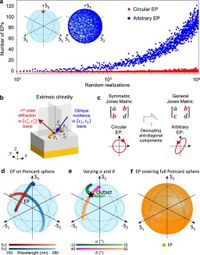In a groundbreaking study published on March 18, 2025, researchers have achieved a remarkable advancement in optics by demonstrating the existence of exceptional points (EPs) with arbitrary polarization control in a single metasurface. This innovative feat, carried out by a collaborative team from Tsinghua University and National Cheng Kung University (NCKU), offers significant implications for applications in photonics and wavefront engineering.
Exceptional points represent unique spectral singularities within non-Hermitian systems where two or more eigenvalues and their corresponding eigenstates coalesce. Traditionally, the phenomenon of EPs has been limited to particular polarization states, mainly circular polarizations corresponding to certain points on the Poincaré sphere, which constrained their practical applications. The new research expands this paradigm by allowing any polarization state along the entire surface of the Poincaré sphere.
The plasmonic metasurface utilized in this study comprises a dielectric layer sandwiched between metallic layers, containing two aluminum nanorods that can be independently controlled. The design exploits the principles of optical anisotropy, chirality, and non-Hermiticity to achieve unprecedented levels of polarization tunability. These features enable the systematic decoupling of the anti-diagonal terms in the Jones matrix, the mathematical representation used to describe polarization transformations in light.
According to the authors of the article, "The non-Hermitian plasmonic metasurface incorporates extrinsic chirality under oblique incidence and local basis transformation decouples the four elements of the Jones matrix and ensures considerably large fine-tuning space." This significant advance encourages the exploration of EPs previously not thought possible and opens new avenues in the realms of optical multiplexing and wavefront shaping.
The experimental validation of this concept involved fabricating the metasurface using standard clean-room processes, followed by intricate measurements. The scanning electron microscope (SEM) images confirmed the successful array fabrication of dual-nanorods oriented at specified angles, which play a crucial role in achieving the desired polarization effects.
It was found that, by varying the angles of incidence when illuminating the metasurface, researchers could achieve coalesced eigenstates that transitioned smoothly across the Poincaré sphere. This feature allows the system to modulate light with linear, circular, and elliptical polarizations, demonstrating versatility that traditional optical systems could not replicate.
Through their rigorous experimental approach, the team highlights the robust nature of these findings. The authors remarked, "These arbitrarily polarized diffraction EPs in plasmonic metasurfaces can cover thus the whole Poincaré sphere and provide new design degrees of freedom together with topologically-protected robustness." This robustness against disturbances enhances the potential for real-world applications, particularly in technologies relying on precise polarization control, such as holography and imaging systems.
During their experiments, the team encoded the “Tsinghua” logo into their metasurface, successfully demonstrating the ability to generate holographic images using light of different polarizations. The findings unveiled that, depending on the incident light's polarization state, distinct holographic images appeared as projected by the metasurface, thereby illustrating the control one's able to achieve with this technology.
This research marks a significant leap forward in the field of photonics, as it not only demonstrates the fundamental properties of EPs in extraordinary detail but also catapults their applications into a new era of technological innovation. By combining unique optical properties with the versatility of metasurfaces, scientists are equipped with new tools for manipulating light in ways previously thought unattainable, thus further bridging the gap between theoretical exploration and practical realization.
Going forward, the team anticipates that this work will catalyze further studies into the behavior of EPs across various systems and encourage the integration of topological principles into the design of future optical devices. They hope to investigate potential applications beyond the realm of polarization control, encompassing more complex multidimensional settings involving nonlinear optics and quantum phenomena.
In conclusion, the exploration of exceptional points within non-Hermitian metasurfaces opens a broader landscape for optical manipulations, promising innovative approaches to address contemporary challenges within the fields of photonics, telecommunications, and light-based technologies. As researchers continue to untangle the complexities of these systems, the horizon for practical applications becomes ever more expansive, paving the way for advancements that could redefine how light is harnessed in technology.




